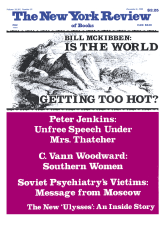In response to:
AIDS Without End from the August 18, 1988 issue
To the Editors:
Diane Johnson and John Murray, in their discussion of the “patient zero” story in Randy Shilts’ book And The Band Played On, say that epidemiologists no longer believe the story. They attribute this opinion to William Darrow in an interview with me.1 This is not correct; the study on which the story is based was Darrow’s; the opinion is mine. I do however feel that it should be his as well.
The patient zero story—in its various versions, that Gaetan Dugas, a Canadian flight assistant, “brought AIDS to” California or San Francisco or the United States—is based on a study by David Auerbach and Darrow published in 1984.2 The study presented a “cluster” in which forty persons among the first few hundred reported with AIDS in the United States were linked together by sexual contact, self-reported or reported by “close companions,” in the five years preceding onset of AIDS symptoms. Mr. Dugas (who was not identified) is placed at the center of the cluster: the inference is that he infected the persons who reported having sex with him, they infected the persons who reported having sex with them, and so on.
However, when the evidence given is examined in detail the cluster dissolves. There are nine of the forty pairs in the cluster for which the time between the alleged exposure and the onset of AIDS symptoms is given; in three of these both the alleged infector and the alleged infectee had onset of symptoms at about the same time; in six more the mean time from sexual contact to symptoms is eleven months. As we now know, the probability of clinical disease within two years of infection is extremely rare and the average time is on the order of eight to ten years: thus it is highly probable that none of these nine reported contacts was in fact responsible for the alleged transmission. No date is given for the other thirty-one contacts but they must be regarded as equally suspect.
Auerbach and Darrow constructed the supposed cluster to reflect what was then believed about the incubation period of AIDS—the time from infection to disease. As they say in the paper, based on studies of Kaposi’s sarcoma in kidney transplants, it was then believed that the incubation period for AIDS was about one year. The cluster was constructed to fit this belief. The cluster is in fact a textbook example of constructing your empirical evidence to fit your theory.
The cluster is a myth. There is very little evidence that Gaetan was “patient zero” for the US or for California. There is, in particular, no reason to believe he “brought the virus to San Francisco.” There were many opportunities for the virus to move from New York to San Francisco in the late 1970s: in a 1983 study3 in which we interviewed about half of the first five hundred AIDS cases in San Francisco (i.e., most of those surviving), a third of those interviewed had had sex in New York in the late Seventies and were therefore eligible as transmitters of the virus.
Mr. Shilts, to give him credit, does not overstress Mr. Dugas’ role. (But he does identify Dugas, and does not cite the Auerbach and Darrow paper.) Elsewhere, however, “patient zero” has been used extensively in marketing the book and its various spinoffs, and the story is still being used. Most recently California Magazine, which serialized the episode from the book, took a half-page advertisement in The New York Times in which it ran Mr. Dugas’ photograph over text beginning: “The AIDS epidemic in America wasn’t spread by a virus. It was spread by a single man…. A Canadian flight attendant named Gaetan Dugas….” This is a rather nasty phenomenon.
AIDS (the disease) is surrounded by an enormous tide of irrationality and folklore which sometimes threatens to rise up into the public health process and swamp it. It is a good idea to have as few myths floating around as possible. Mr. Shilts and Dr. Darrow should both repudiate the “patient zero” story.
Andrew R. Moss, Ph.D.
Department of Epidemiology and
International Health
University of California, San Francisco
Diane Johnson and Dr. John F Murray replies:
We thank Andrew Moss for bringing Dr. Darrow’s paper to our attention and are sorry that the footnote seemed to attribute this point to Dr. Darrow. We certainly agree with Mr. Moss’s position.
This Issue
December 8, 1988
-
1
The New York Review (August 18, 1988).
↩ -
2
D.M. Auerbach, W.W. Darrow, H.W. Jaffe, and J.W. Curran. Cluster of cases of the acquired immune deficiency syndrome. Patients linked by sexual contact (The American Journal of Medicine, No. 76, 1984, pp. 487–492).
↩ -
3
A.R. Moss, D. Osmond, P. Bacchetti, J.-C. Chermann, F. Barre-Sinoussi, and J. Carlson. Risk factors for AIDS and HIV seropositivity in homosexual men (American Journal of Epidemiology, No. 125, 1987, pp. 1035–1047).
↩



